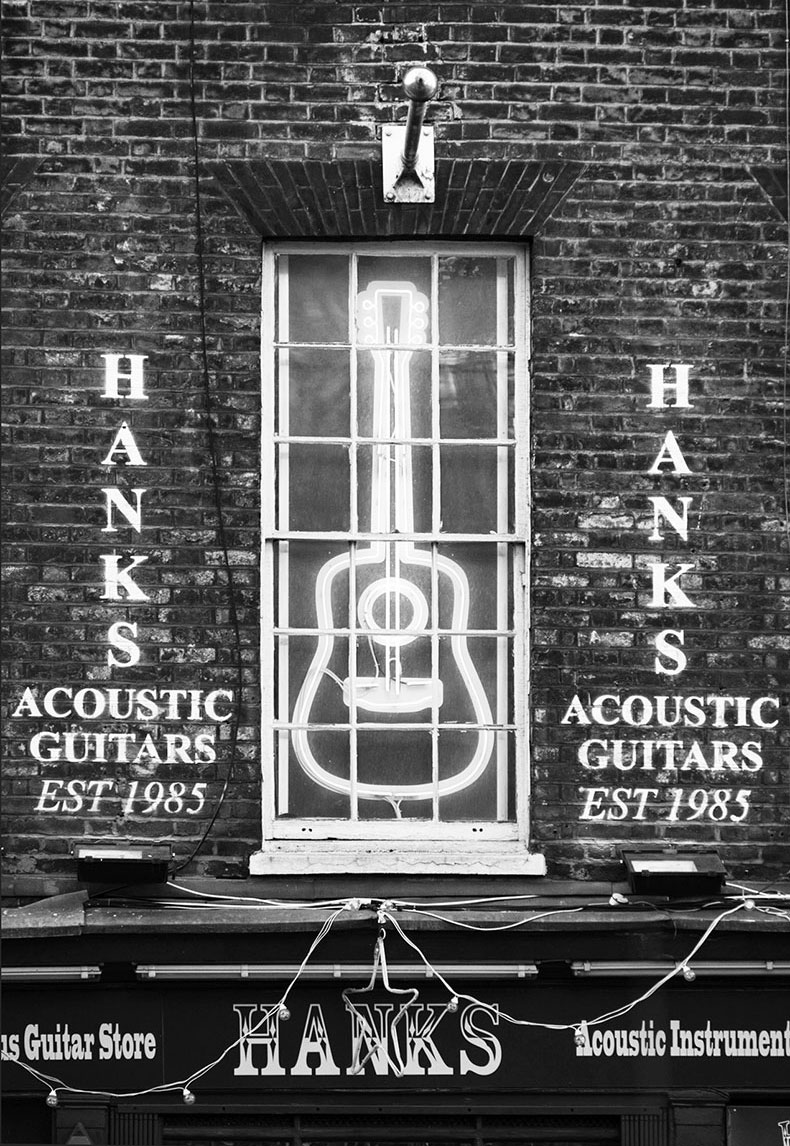For more than a century, Denmark Street has been the spiritual home of music in London. These days it’s where giddy teens and grizzled pros purchase shiny guitars, but before that it played a founding role in the careers of The Beatles, the Rolling Stones, David Bowie, Elton John, the Sex Pistols and more. But this history goes back even further. Before the Second World War, Denmark Street was home to music publishers, their windows piled high with sheet music for hits like South of the Border and Lambeth Walk. Even now, following major development, Denmark Street clings on as London’s street of sound.
But why Denmark Street? Several factors – historical, topographical and architectural – could tell us something about why some parts of a city thrive in the face of change. Let’s start at the beginning: Denmark Street is a short street of about 60 metres at the top of Charing Cross Road, near the junction of Oxford Street and Tottenham Court Road. It was laid out in the 1700s as a residential street for the parish of St Giles, a famously dissolute area that once housed a leper hospital and never really recovered. Charing Cross Road became known for its bookshops, so when music publisher Lawrence Wright moved to London from Leicester in 1911, the location made sense. Music was originally a branch of bookselling because, in the decades before cheap recorded music, the only way to hear a popular song at home was if you played it yourself. Sheet music was the thing and a publisher could make a fortune from the right song – as Wright did, many times over.
Hank’s guitar shop at No 27, Denmark Street. Photo: Rob Telford

It helped that Denmark Street was a shortcut between the theatre districts of Soho and Covent Garden. If a musician needed to learn a popular song, they came to Denmark Street to get the music. As other publishers followed in the footsteps of Wright the street also began to attract songwriters, who would play new compositions to publishers using the office piano. Then came the pluggers, whose role was to persuade popular artists to perform a recently acquired song. All these individuals would intermingle in the street’s cafés or local pubs, swapping ideas and developing networks.
This was how things worked for decades. Change came with rock and roll, and the availability of cheap vinyl. But Denmark Street adapted as recording studios appeared on the street to cater to a new generation of self-taught musicians. This adaptability was helped by the architecture: rambling Georgian properties were easy to convert to multiple occupancy. Anybody associated with music could find an office somewhere on Denmark Street and you can see the variety through some of the street’s most famous artists: the Rolling Stones recorded at No 4; The Beatles signed a groundbreaking publishing deal on the corner with Charing Cross Road; David Bowie recruited band members at La Gioconda café at No 9; Elton John worked as an office boy at one of the remaining publishers, before their talent-spotting role was taken over by record labels.
The 12 Bar Club at No 26 before it closed in 2015. It has since reopened as The Lower Third, named after one of David Bowie’s backing bands formed on Denmark Street. Photo: Rob Telford

By the end of the 1960s, the publishers had left. Denmark Street was again at a point of change. There was no real reason for music to survive, other than the fact so many musicians, managers and agents still visited the street every day. To serve their needs, instrument shops began to dominate the street while the architecture meant there were all sorts of old, forgotten spaces, perfect for music. The Sex Pistols rehearsed in a workshop behind No 6, and a blacksmith forge was converted into the 12 Bar Club, one of London’s best small venues. Both are listed by English Heritage along with other properties on the street, in part because of their rich musical associations.
And today? Although the arrival of Crossrail has caused drastic change, Denmark Street survives. The last publisher, Noel Gay, has gone but the instrument shops are still there beneath offices that have been converted into bedrooms for Chateau Denmark, a rock-themed hotel. The 12 Bar Club is now the Lower Third – the name of one of Bowie’s Denmark Street-era bands – while further down the street a new recording studio is planned. It’s not the same, but it never really was one thing. Denmark Street survives because it evolves, as resolute, adaptable and essential as music itself.
Peter Watts is the author of Denmark Street: London’s Street Of Sound, published by Paradise Road.


